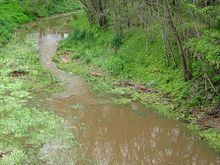- right Skillogalee Creek - elevation 429 m (1,407 ft) - elevation 0 m (0 ft) | - location Merildin Basin area 1,913 km² Country Australia | |
 | ||
- left Pine Creek, Woolshed Flat Creek Mouths | ||
The Wakefield River is an ephemeral river that is part of an estuary located in the Australian state of South Australia.
Contents
Map of Wakefield River, South Australia, Australia
Course and features
The river rises above Merildin, flowing southward, passing the towns of Watervale and Auburn, where it is fed by several small creeks, and then curves to flow westerly past the town of Balaklava into the head of Gulf St Vincent at Port Wakefield.
The river's catchment area covers 1,913 square kilometres (739 sq mi). Three quarters of the catchment is used for agricultural purposes.
The major tributaries of the Wakefield River are the Eyre, Skillogalee, Pine, Rices, Hermitage and Woolshed Flat Creeks. Skillogalee Creek, which rises in the Skilly Hills near Penwortham, is a significant tributary of the Wakefield River. The high rainfall in the Skilly Hills contributes to the Skillogalee Creek being one of the few permanently flowing watercourses in the region. Dennis Creek is another tributary of the Wakefield River. It is a very short ephemeral stream which is located in the Clare Valley town of Auburn and only flows during periods of rain. Its headwaters are located in the hills on the western side of the town and it runs along a small gully, passing under Main North Road, and into the Wakefield River. The creek was named after the father of C.J. Dennis, who ran a hotel in the town for a time.
History
The first European to discover it was John Hill (incorrectly named William Hill by some sources) in early April 1839, who named it after Edward Gibbon Wakefield, the promoter of the scheme of systematic colonization that led to the founding of the Colony of South Australia. Hill was embarked upon the expedition which led to his discovery of the Clare Valley. The second European to visit was explorer Edward John Eyre, in late May 1839, who records that he encamped, 'upon a chain of large ponds of excellent water called by Mr. Hill the Wakefield.'
